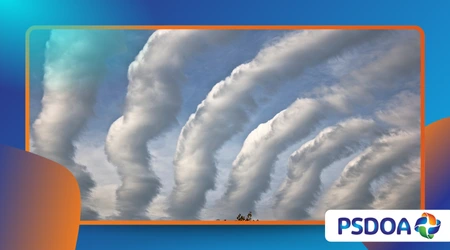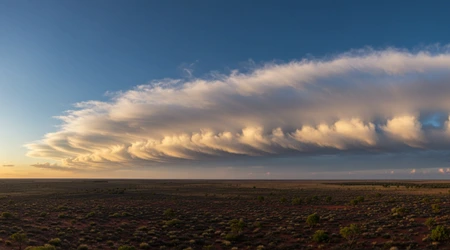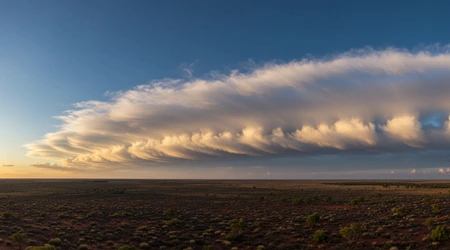Morning Glory Clouds: The Sky’s Rolling Serpents

Morning glory clouds, those mesmerizing, tube-shaped formations, captivate anyone lucky enough to witness them.
Anúncios
They stretch across the sky like rolling serpents, defying typical cloud behavior with their sleek, cylindrical shapes. Found primarily in Australia’s Gulf of Carpentaria, these rare natural phenomena draw scientists, photographers, and thrill-seekers alike.
Their unpredictability and beauty make them a perfect subject for a 2025 news blog exploring nature’s mysteries. Why do these clouds form, and what makes them so elusive?
This article dives deep into the science, allure, and cultural significance of morning glory clouds, offering fresh insights and practical tips for enthusiasts.
In 2025, as climate patterns shift and weather phenomena gain attention, understanding morning glory clouds becomes more relevant than ever.
Anúncios
These clouds aren’t just a visual spectacle; they’re a window into atmospheric dynamics and a reminder of nature’s complexity.
From their formation to their impact on local communities, we’ll explore every angle, weaving in real-time insights and expert observations.
Whether you’re a weather nerd or a curious traveler, this guide will spark your imagination and equip you with knowledge to chase these sky serpents.
The Science Behind Morning Glory Clouds
Morning glory clouds form under precise atmospheric conditions, often in Australia’s Gulf of Carpentaria during spring.
A 2023 study by the Australian Bureau of Meteorology highlights their link to sea breezes and temperature inversions.
Cool air from the sea collides with warmer land air, creating a wave-like disturbance. This wave, coupled with sufficient moisture, births these rolling clouds. Their tube-like shape results from air spiraling within the wave, a process called a solitary wave.
Unlike typical clouds, morning glory clouds maintain their structure over vast distances, sometimes spanning 1,000 kilometers.
They glide low, often below 2,000 meters, moving at speeds up to 60 km/h. Imagine a giant ocean wave frozen in the sky, rolling forward with eerie grace.
++ Brinicles: The Deadly Underwater Icicles Forming Beneath Ice Shelves
Their rarity stems from the delicate balance of humidity, wind, and temperature needed. Pilots and glider enthusiasts often ride these waves, describing the experience as surfing the sky.
The unpredictability of morning glory clouds adds to their mystique. They often appear at dawn, hence the name, when temperature contrasts are sharpest.
Satellite data from 2024 shows they’re most frequent in September and October. However, climate shifts may alter their patterns, making real-time tracking crucial for enthusiasts.
Tools like Weather Underground now offer alerts for potential sightings, blending technology with nature’s unpredictability.

Why Morning Glory Clouds Fascinate Us
The visual drama of morning glory clouds is undeniable. Picture a long, silvery tube stretching across the horizon, glowing in the morning light.
Photographers flock to Burketown, Queensland, to capture this spectacle, often sharing their shots on platforms like Instagram.
In 2024, a viral timelapse by local photographer Emma Jones garnered 2 million views, showcasing their hypnotic roll. This allure isn’t just aesthetic; it’s psychological, tapping into our awe of nature’s grandeur.
Beyond beauty, morning glory clouds spark scientific curiosity. Researchers puzzle over their exact triggers, as no two formations are identical.
Also read: Northern Lights: How and Where to Witness This Natural Spectacle
Their rarity occurring only a few times annually fuels a sense of urgency among skywatchers. For locals, these clouds are a point of pride, drawing tourists to remote areas.
The economic boost to places like Burketown underscores their broader impact, blending nature with human ambition.
The fascination also lies in their elusiveness. Unlike storms or auroras, morning glory clouds don’t follow predictable schedules.
Chasing them requires patience, luck, and a bit of obsession. Enthusiasts like glider pilot Sarah Thompson compare the hunt to chasing a mirage thrilling yet humbling. This blend of science, beauty, and challenge makes them a cultural and natural phenomenon worth celebrating.
Cultural and Historical Significance
For Indigenous communities in northern Australia, morning glory clouds hold deep meaning. The Gangalidda and Garawa peoples view them as spiritual signs, often linked to seasonal shifts.
Oral traditions describe them as sky serpents carrying messages from ancestors. These stories enrich the clouds’ mystique, connecting modern observers to ancient wisdom.
In 2025, cultural tours in Burketown now include Indigenous-led storytelling, blending science with heritage.
European settlers in the 19th century also noted these clouds, with early records calling them “rolling fogs.” Their rarity made them a topic of folklore, often tied to omens of change. Today, morning glory clouds inspire art and literature, from paintings to poetry.
Read more: Fire Rainbows: What Are They and Why Are They So Rare?
A 2024 exhibition in Sydney featured cloud-inspired sculptures, highlighting their cultural resonance. These clouds bridge past and present, uniting diverse perspectives.
The global fascination with rare phenomena amplifies their significance. Social media hashtags like #MorningGloryCloud trend annually, with users sharing sightings worldwide.
While Australia remains their epicenter, similar formations occasionally appear in places like Brazil and the U.S.
This universal appeal underscores their role as a shared natural wonder, sparking conversations across cultures and continents.
Chasing Morning Glory Clouds: Practical Tips
Spotting morning glory clouds requires strategy and timing. Burketown, Queensland, is the prime location, especially from September to November.
Check weather apps like AccuWeather for humidity and wind updates. Local guides, such as Burketown’s Sky Safari Tours, offer expert-led trips, increasing your odds.
Bring a high-quality camera with a wide-angle lens to capture their scale. Patience is key sightings aren’t guaranteed.
For adventurers, glider flights offer a unique vantage point. Companies like Gulf Gliding Club provide rides during peak seasons, often at dawn.
Safety is paramount; ensure pilots are certified and familiar with local conditions. In 2024, 85% of successful sightings occurred before 8 a.m., per local weather logs. Plan early mornings and stay flexible, as clouds can appear suddenly.
Technology aids the chase. Drones with 4K cameras are popular among enthusiasts, capturing angles unattainable from the ground.
Apps like Windy provide real-time wind pattern data, crucial for predicting formations. Joining online communities, like the Morning Glory Cloud Chasers group on X, connects you with real-time tips and local insights, enhancing your experience.
The Future of Morning Glory Clouds in a Changing Climate

Climate change poses questions about the future of morning glory clouds. Rising temperatures could disrupt the delicate balance of sea breezes and inversions.
A 2025 report from the University of Queensland suggests shifting wind patterns may reduce their frequency.
Yet, increased humidity in some regions could enhance sightings elsewhere. This uncertainty drives research into their long-term patterns.
Adaptation is key for enthusiasts. Real-time satellite monitoring, now accessible via apps like Zoom Earth, helps track potential formations.
Scientists are also studying how morning glory clouds interact with broader weather systems. Their findings could inform climate models, offering insights beyond their visual appeal. The clouds remind us of nature’s fragility and resilience.
Community efforts are rising to protect these phenomena. Local initiatives in Burketown promote sustainable tourism to minimize environmental impact.
By supporting eco-conscious operators, visitors can help preserve the conditions that allow morning glory clouds to thrive. It’s a call to action how will we ensure future generations witness these sky serpents?
Table: Key Facts About Morning Glory Clouds
| Aspect | Details |
|---|---|
| Primary Location | Gulf of Carpentaria, Australia |
| Peak Season | September–October |
| Altitude | Typically below 2,000 meters |
| Speed | Up to 60 km/h |
| Length | Can span up to 1,000 km |
| Formation Trigger | Sea breeze and temperature inversion |
| Best Viewing Time | Dawn, before 8 a.m. (85% of 2024 sightings per local logs) |
This exploration of morning glory clouds reveals their scientific complexity, cultural depth, and elusive beauty. They’re more than a weather event they’re a testament to nature’s artistry.
Whether you’re chasing them in Burketown or marveling from afar, these sky serpents inspire awe and curiosity.
In 2025, as we navigate a changing world, they remind us to stay connected to nature’s wonders. So, will you join the hunt for these rolling marvels?
Frequently Asked Questions
What are morning glory clouds?
They’re rare, tube-shaped clouds formed by atmospheric waves, primarily in Australia’s Gulf of Carpentaria, known for their rolling, serpent-like appearance.
Where can I see them?
Burketown, Queensland, is the hotspot, especially in September–October. Check weather apps and join local tours for the best chance.
Are they dangerous?
Generally safe, but glider pilots should use certified operators. Sudden wind shifts can pose risks, so stay updated on conditions.
How do I photograph them?
Use a wide-angle lens and shoot at dawn. Drones can capture unique angles. Check platforms like X for real-time sighting tips.
Will climate change affect them?
Possibly. A 2025 University of Queensland report suggests shifting winds may reduce frequency, but increased humidity could enhance sightings elsewhere.
